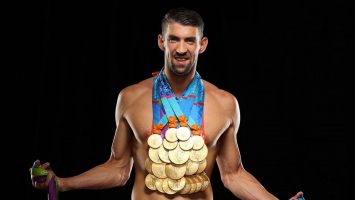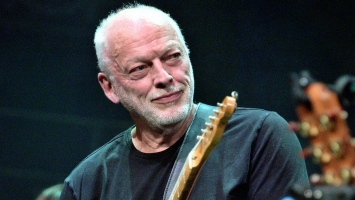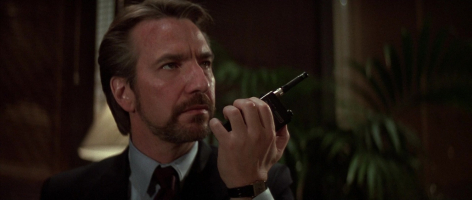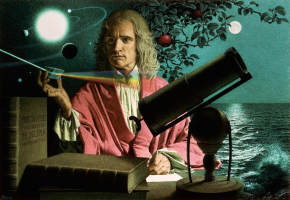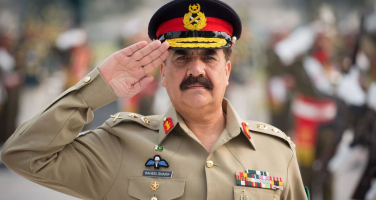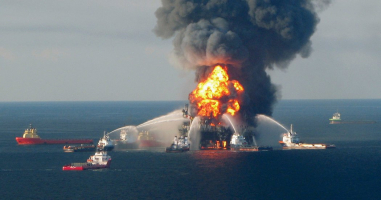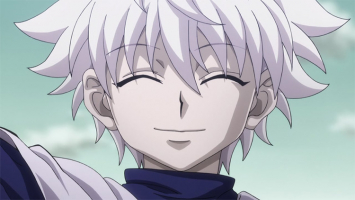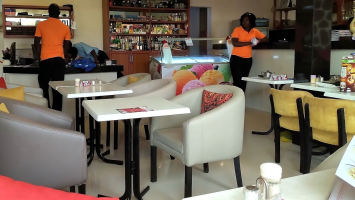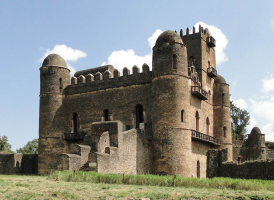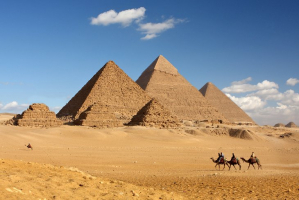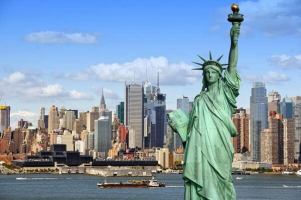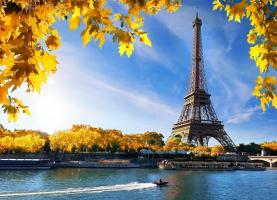Top 10 Greatest Plays in NFL Playoff History
What constitutes a great play is often in the eye of the beholder. Great plays, and great controversies, are magnified during the playoffs, when every game is ... read more...televised to a national audience. And the NFL has generated plenty of both in the playoffs going back, at least here, to 1958. Here is a subjective list of the top 10 greatest Plays in NFL Playoff History.
-
The NFL Playoffs for the 2015 season began on January 9, 2016, with a wildcard game between the Kansas City Chiefs and the Houston Texans in Houston. Knile Davis, a Chiefs return specialist and running back, caught the first kickoff six yards deep in his end zone. He chose to run it out. He arrived in the Texans' endzone 11 seconds later, having made the longest kickoff return in NFL playoff history. It was also the fastest playoff score in history.
The Texans never recovered from their shock. They were down 13-0 at halftime, and the game concluded 30-0. During the onslaught, the Chiefs had four interceptions. It was the first time the Texans had failed to score in a home game. In the end, the only points the Chiefs needed to win their first playoff game in 26 years came on the opening kickoff. By the way, Davis' kickoff return was not his longest. During his rookie season in 2013, he returned a kickoff 108 yards for a touchdown against the Denver Broncos, tying the second-longest return in NFL history. Three players currently hold the record of 109 yards.
Date: 2015
Venue: Arrowhead Stadium
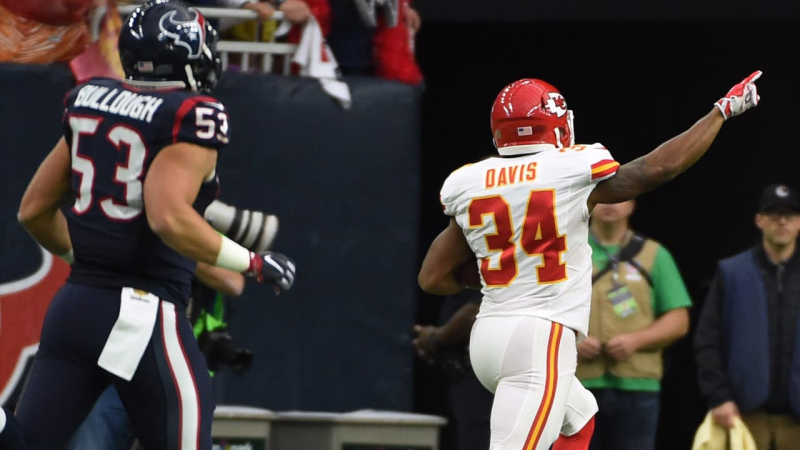
chiefs.com 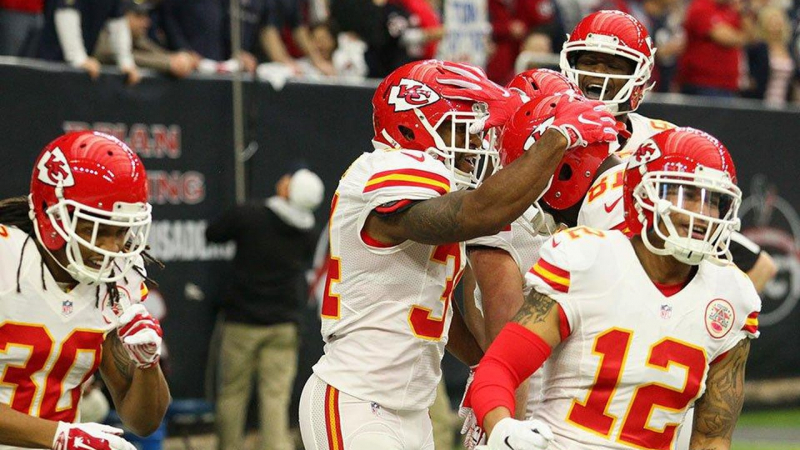
chiefs.com -
The Seattle Seahawks, the previous year's champions, faced the New England Patriots, who had not won a championship in 10 years, in Super Bowl XLIX. The game, which took place on February 1, 2015, pitted Seattle's Legion of Boom defense against New England's powerful attack. However, it was New England's defense that finished the winning play. Seattle led by ten points in the third quarter, but the Patriots scored two touchdowns in the fourth to take a 28-24 lead late in the game.
The Seahawks weren't done with just two minutes and two seconds left. With 26 seconds left, they drove from their own 20 yard line to the Patriot one, where they faced second and goal. Some fans were perplexed when the Seahawks called a pass play and Malcolm Butler intercepted the ball. The game was not ended by the play. A penalty for excessive celebrating made the prospect of a Patriots safety a reality. However, an encroachment penalty on Seattle pushed the ball back, and a subsequent altercation resulted in a personal foul on the Seahawks, pushing them even farther back and enabling Tom Brady enough freedom to take a knee and run out the clock.
Date: February 1, 2015
Venue: University of Phoenix Stadium, Glendale, Arizona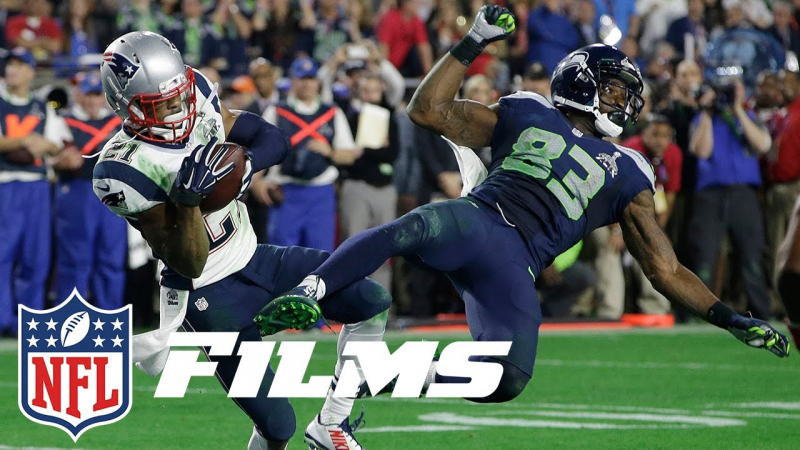
bleacherreport.com 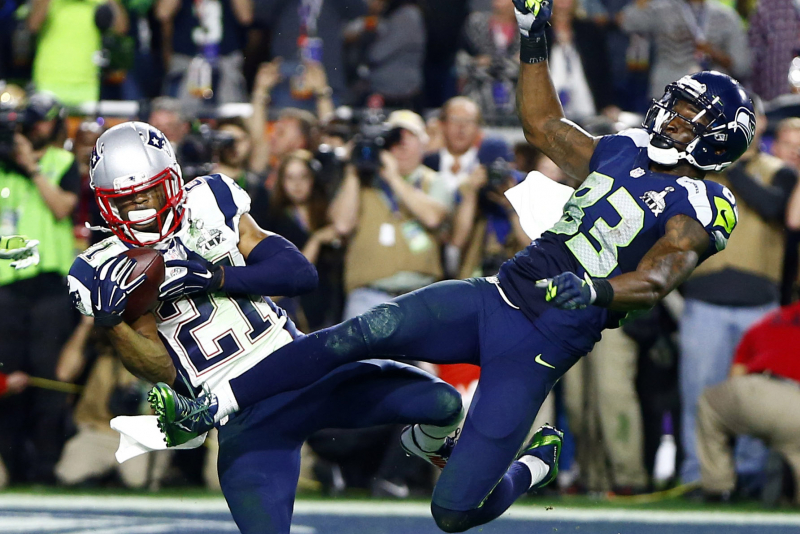
bleacherreport.com -
The Raiders, who were based in Oakland at the time, faced the Baltimore Colts in an AFC Divisional Playoff game on Christmas Eve 1977. The game swung back and forth in the second half, with Oakland trailing the Colts by three points late in the fourth quarter. They received the ball on their own 30-yard line with just under three minutes remaining. To force overtime, Raider quarterback Ken Stabler needed to get the club into field goal range.
He got them there with a 42-yard completion to tight end Dave Casper (nicknamed "the Ghost" by teammates after Casper the Friendly Ghost) on a play called "Ghost to the Post" by the Raiders. Casper changed his route and made an over-the-head catch of the high-arching pass, putting the Raiders in field goal range. A few plays later, the Raiders knotted the score, forcing overtime. Casper grabbed a 10-yard throw from Stabler in the second overtime to win the game, but it would not have been possible without the athletic reception he made late in the fourth quarter.
Date: December 24, 1977
Venue: Memorial Stadium, Baltimore, Maryland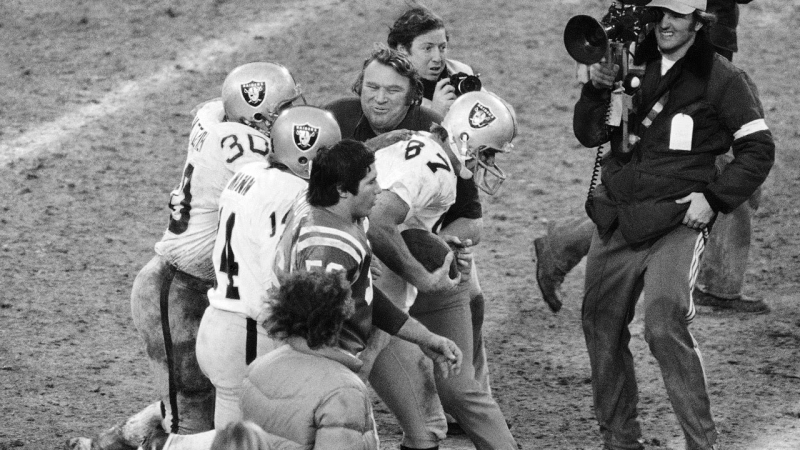
youtube.com -
Ben Roethlisberger’s touchdown pass to Santonio Holmes is one of the greatest plays in NFL Playoff history. Super Bowl XLIII (43 for those challenged by Roman numerals) is remembered for, among other things, being the last appearance in the television booth by the late John Madden. It also featured a 100 yard interception return for a touchdown by Steelers linebacker James Harrison. Despite that play and other heroics, with 2:37 remaining to play, Pittsburgh trailed the Arizona Cardinals 23-20.
Pittsburgh, led by Ben Roethlisberger, moved 78 yards, with Santonio Holmes accounting for 73 of those yards. The drive ended with a six-yard throw in the back corner of the end zone, when Holmes made one of the most amazing catches in NFL playoff history. Some fans consider the game to be the best in Super Bowl history, however few of them are Arizona fans. The play gave Pittsburgh its sixth Super Bowl victory, making them the only team to achieve such sustained success.
Date: 2006
Venue: Tampa, Fla
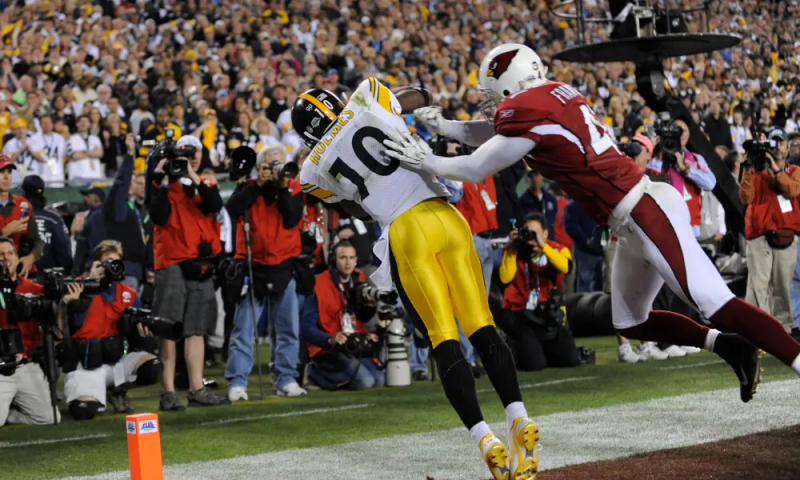
steelerswire.usatoday.com 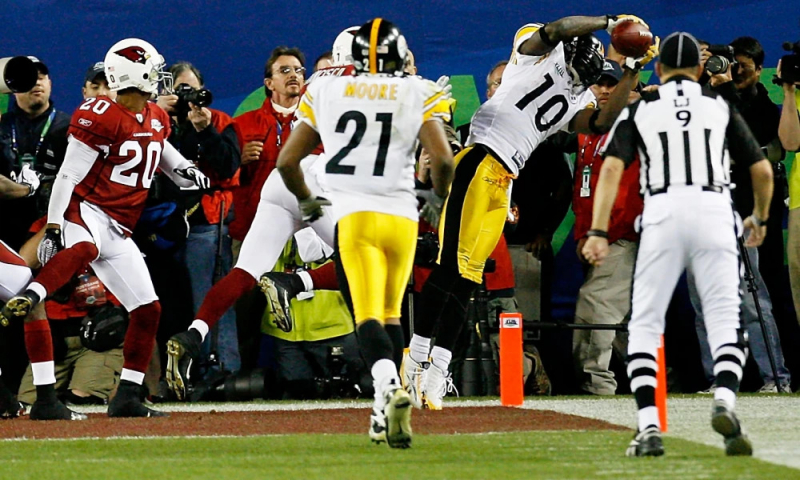
steelerswire.usatoday.com -
On New Year's Eve 1967, the Dallas Cowboys faced the Green Bay Packers in a rematch of the NFL Championship Game from the previous season. It is still the coldest NFL game in history. The weather in cold Green Bay was - 12 degrees at game time. It was dubbed the Ice Bowl. The mechanism designed to keep the playing field at Lambeau Field from freezing failed. Several players got frostbite. Some players thought the game would be rescheduled. Officials pondered canceling the game until they realized that the next day would be considerably colder. The game went on, but the Wisconsin-La Crosse marching band's pregame performance was canceled because their lips froze to their mouthpieces.
The game was fiercely contested. With 16 seconds remaining in the fourth quarter and Dallas leading 17-14, Green Bay performed a 67-yard drive that brought them to the one-yard line (really about a foot from the goal line). People watching the game could see the time left, yard line, down, score, and the temperature, which was - 20 degrees. On the next play, Packer guard Jerry Kramer pushed Cowboy defensive tackle Jethro Pugh off the line of scrimmage, allowing quarterback Bart Starr to dive across for the touchdown and a Packer victory. It was their third consecutive NFL Championship.
Date: New Year's Eve, 1967
Venue: Lambeau Field in Green Bay, Wisconsin
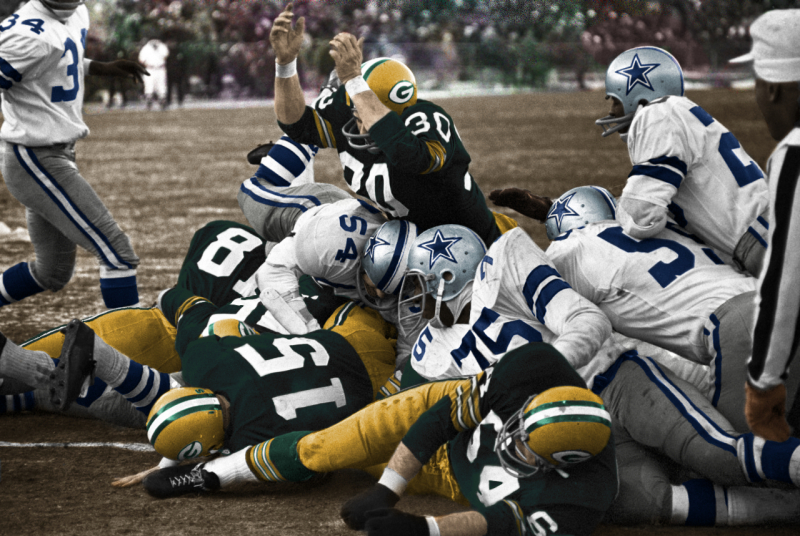
greenbaybobfox.wordpress.com 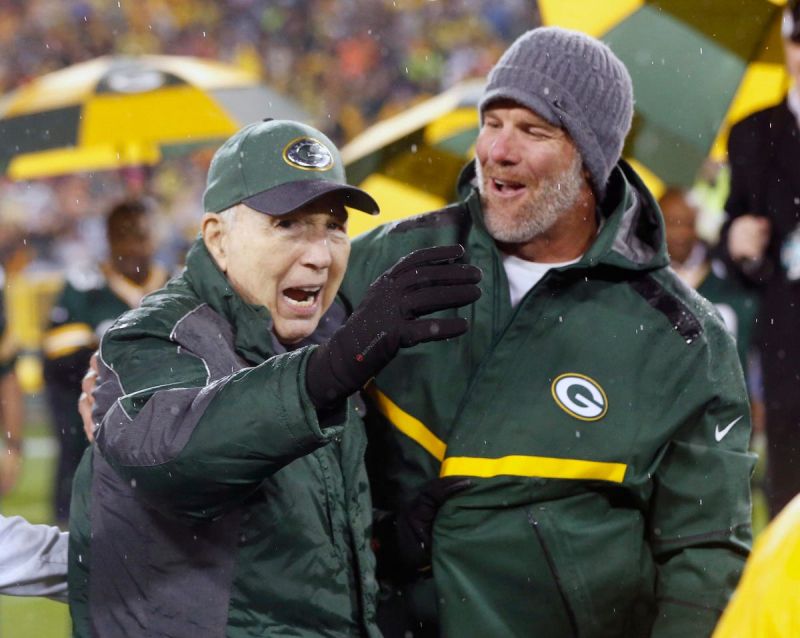
forbes.com -
As of this writing, the Cleveland Browns are one of just four teams that have never appeared in a Super Bowl. But they've come close, never closer than when they faced the Denver Broncos at Mile High Stadium on January 17, 1988. Trailing 21-3 at halftime, the Browns rallied in the third and fourth quarters, powered by running back Earnest Byner and quarterback Bernie Kosar. Following Denver's late touchdown, the Browns launched another drive, reaching the Denver eight-yard line. On second and five, Kosar passed to Byner, who sprinted to his left, picked up the first down, and proceeded into the end zone.
He made it to the end zone, but the ball did not. Unblocked Bronco defender Jeremiah Castille hit Byner at the three-yard line. Castille later admitted that he knew he couldn't stop Byner and pursued the ball nevertheless. He was successful in breaking it loose, and the Broncos recovered. Denver purposefully gave away a safety after forcing Cleveland to use their timeouts. Denver now leads the series 38-33. Cleveland recovered the ball in time for a Hail Mary from midfield, which was unsuccessful. Earnest Byner gained 67 yards and a touchdown on the ground and 120 yards and another touchdown on the ground that day. He is remembered for what became known as "The Fumble," which to Cleveland fans is yet more piece of evidence that all of their sports teams are cursed.
Date: January 17, 1988
Venue: Mile High Stadium
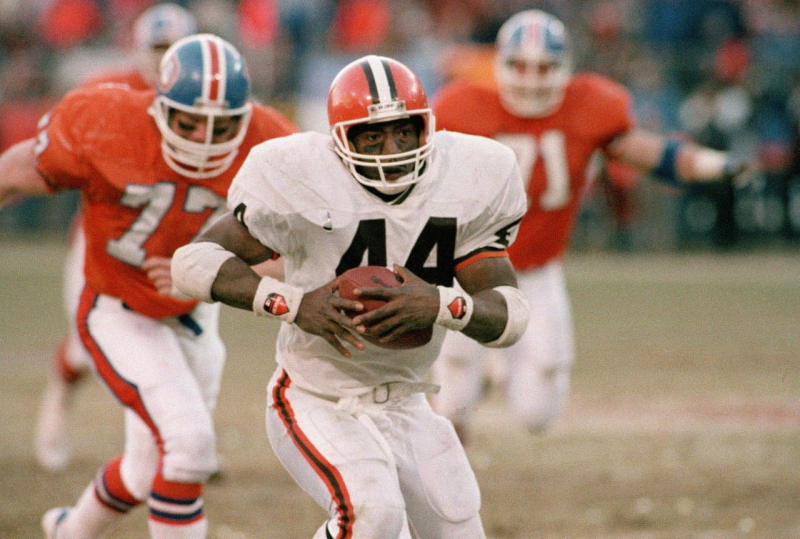
joemontanasrightarm.com 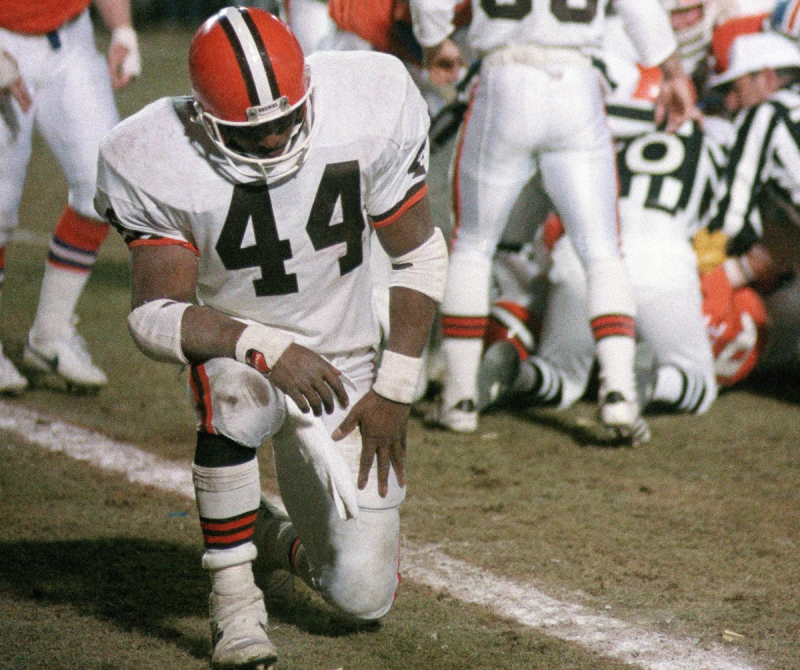
joemontanasrightarm.com -
The Immaculate Reception is one of the greatest plays in NFL Playoff History. When the Pittsburgh Steelers faced the Oakland Raiders in an AFC divisional playoff game on December 3, 1972, they had a long history of failure in the NFL. The Steelers had never won a postseason game up to that point. The drought appeared to be continuing in the fourth quarter. Late in the third quarter, the Raiders led 7-6. With 30 seconds remained in regulation, Steelers QB Terry Bradshaw completed a deep pass to receiver John Fuqua. What happened next is still debatable. The ball either struck Fuqua's helmet, his hands, or Raiders safety John Tatum's hands. It bounced backwards, going for the earth. Franco Harris, the Steelers' running back, received the ball and sprinted to the end zone for the game-winning touchdown. It became known as the Immaculate Reception.
On December 3, 1972, the Pittsburgh Steelers faced the Oakland Raiders in an AFC divisional playoff game. At the time, the Steelers had never won a playoff game. The drought appeared to be continuing into the fourth quarter. Late in the quarter, the Raiders lead 7-6. With 30 seconds remaining in regulation, Steelers QB Terry Bradshaw completed a deep throw to receiver John Fuqua. What happened next is still debated. The ball either struck Fuqua's helmet, his hands, or the hands of Raiders safety John Tatum. It ricocheted backwards, aiming for the earth. Steelers running back Franco Harris received the ball and sprinted to the end zone for the game-winning touchdown.
Date: December 23, 1972
Venue: Three Rivers Stadium, Pittsburgh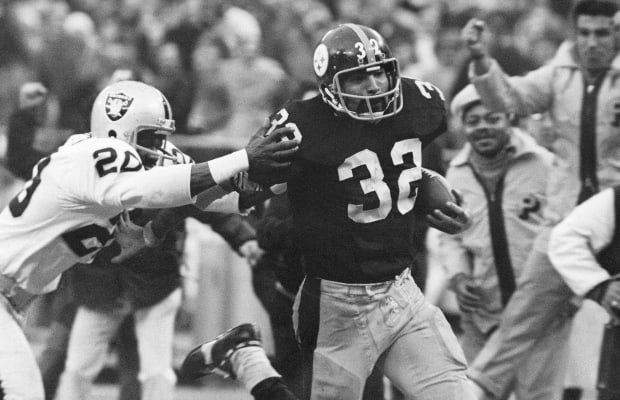
history.com 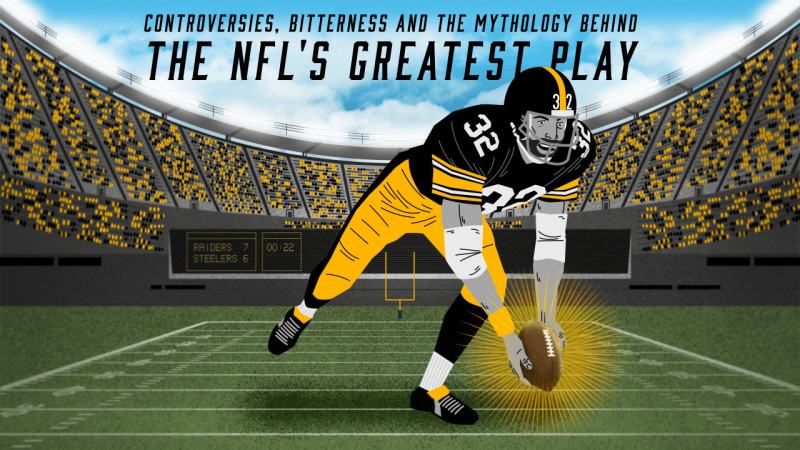
nfl.com -
The 1958 NFL Championship Game between the Baltimore Colts and the New York Giants, dubbed "The Greatest Game Ever Played," featured 12 players who were subsequently inducted into the NFL Hall of Fame. The Giants' Frank Gifford, Sam Huff, and Don Maynard were among them. The Colts included Johnny Unitas, Raymond Berry, and Gino Marchetti. Tom Landry and Vince Lombardi, two legendary coaches and competitors, led the New York defense and offense, respectively. Weeb Ewbank, the Colts' head coach, joined them in the Hall of Fame.
NBC broadcast the game nationally, and 45 million people tuned in despite a blackout in the New York region. Unitas led the Colts on a late-fourth-quarter drive, the first to use the two-minute drill, that tied the game with a field goal with seven seconds remaining in regulation. The Giants received the football first when the game went into sudden death overtime. They failed to advance, punted, and Unitas led the Colts on an 80-yard drive to the one-yard line of New York. Alan Ameche then scored the game-winning touchdown on a third-down play. College football was more popular in the United States than professional football until the 1958 championship. Following the game NFL popularity exploded on the still relatively new medium of television, and has grown with it ever since.
Date: 1958
Venue: Yankee Stadium
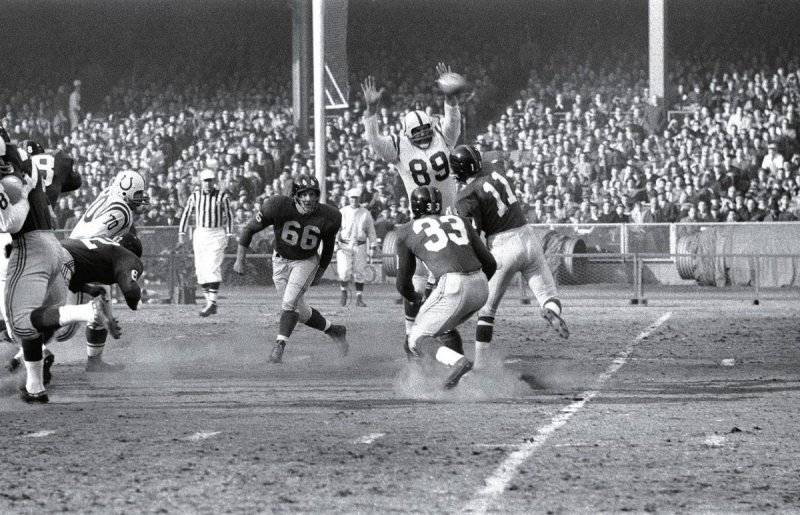
colts.com 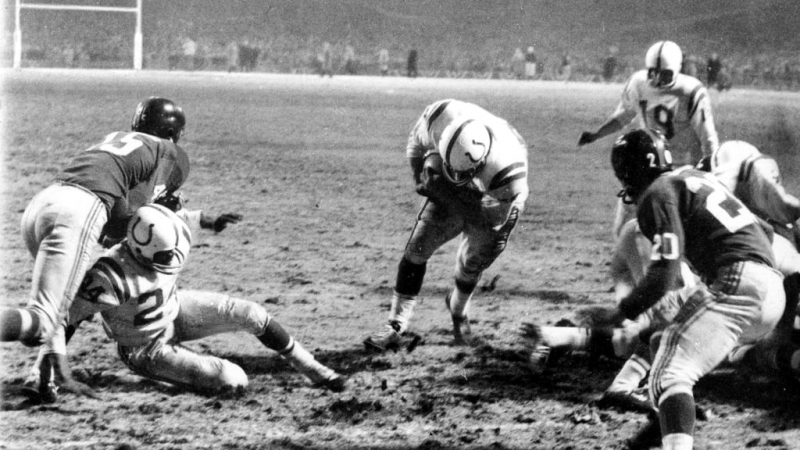
colts.com -
The 1981 NFL Championship Game, played on January 10, 1982, featured the San Francisco 49ers against the Dallas Cowboys. The Cowboys led 27-21 late in the fourth quarter. With little under five minutes remaining, San Francisco received the ball on their own 11-yard line. With 58 seconds remaining, 49ers quarterback Joe Montana led the team on a drive that put them on the Dallas six. Montana found wide receiver Dwight Clark at the back of the end zone on third and four, with a possible first down if they progressed to the Dallas two. Clark's fingertips produced a leaping, twisting catch. The Niners had the lead, but Dallas still had 50 seconds to drive for a game winning field goal.
The Cowboys drove to midfield before their offensive stalled, and the 49ers triumphed. The game-winning play became known as "The Catch," despite the fact that neither Montana nor 49ers head coach Bill Walsh witnessed it. Montana fell down after being hit, and Walsh assumed the ball had been thrown away because of its altitude in the end zone. The 49ers went on to win the Super Bowl that year, as well as three more during the decade. The Cowboys experienced a period of decline. The Catch was ranked second on NFL Films' list of the 100 Greatest NFL Plays of All Time in 2019.
Date: January 10, 1982
Venue: Candlestick Park, San Francisco, California
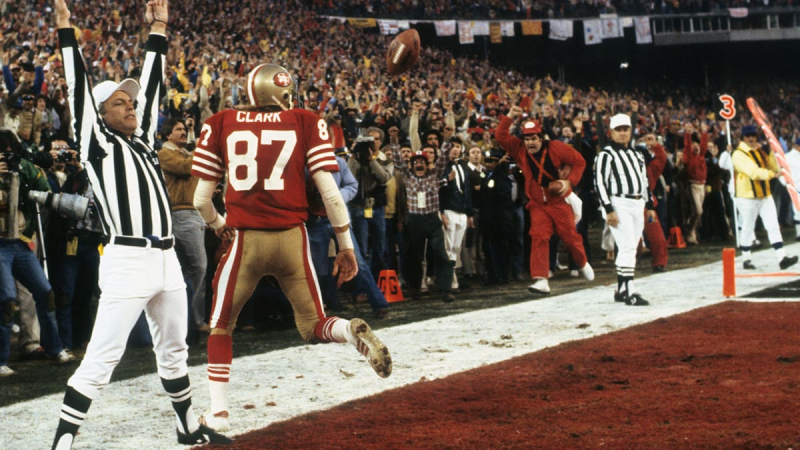
youtube.com 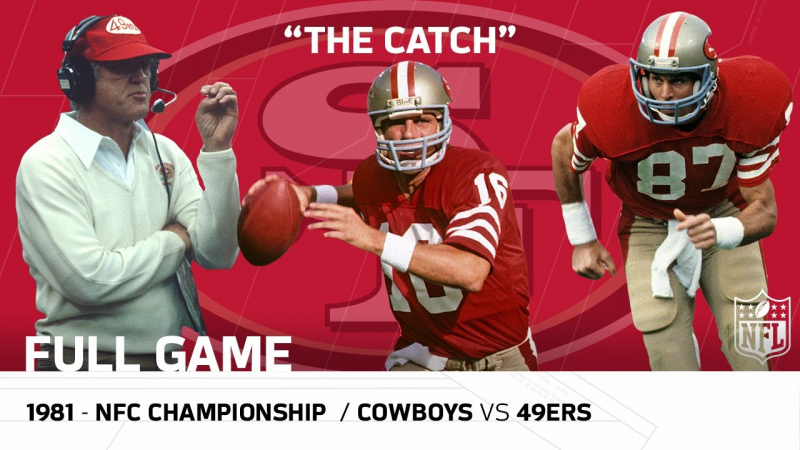
youtube.com -
Many think that the last second deep pass to or near the end zone known as the Hail Mary was so named on December 28, 1975, during a divisional playoff game. The Dallas Cowboys were down 14-10 against the Minnesota Vikings. With 32 seconds remaining in the game, they possessed the ball near midfield. Roger Staubach fired a desperate pass downfield fifty yards to Drew Pearson. Pearson was knocked to the ground after colliding with a defender while adapting to the ball. There were no flags thrown. Dallas won thanks to the grab, moving them to the NFC Championship game. Staubach later told reporters, "It was a Hail Mary pass." The moniker stayed.
It wasn't the first time the moniker had been given to a desperate play. Players at the University of Notre Dame used the word as early as the 1920s. Georgetown utilized it in the 1940s, and Staubach called a Hail Mary throw against Michigan while playing for Navy. However, the 1975 action took place in the NFL playoffs, on a national platform via television. The Cowboys went on to defeat Los Angeles in the NFC Championship before falling to Pittsburgh in Super Bowl X, and the Hail Mary has been a staple of close NFL games ever since.
Date: December 28, 1975
Venue: Bloomington, Minnesota
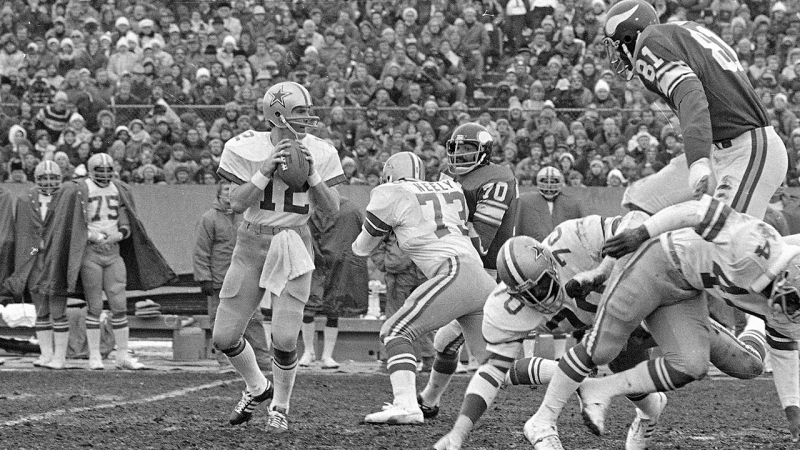
abc7ny.com 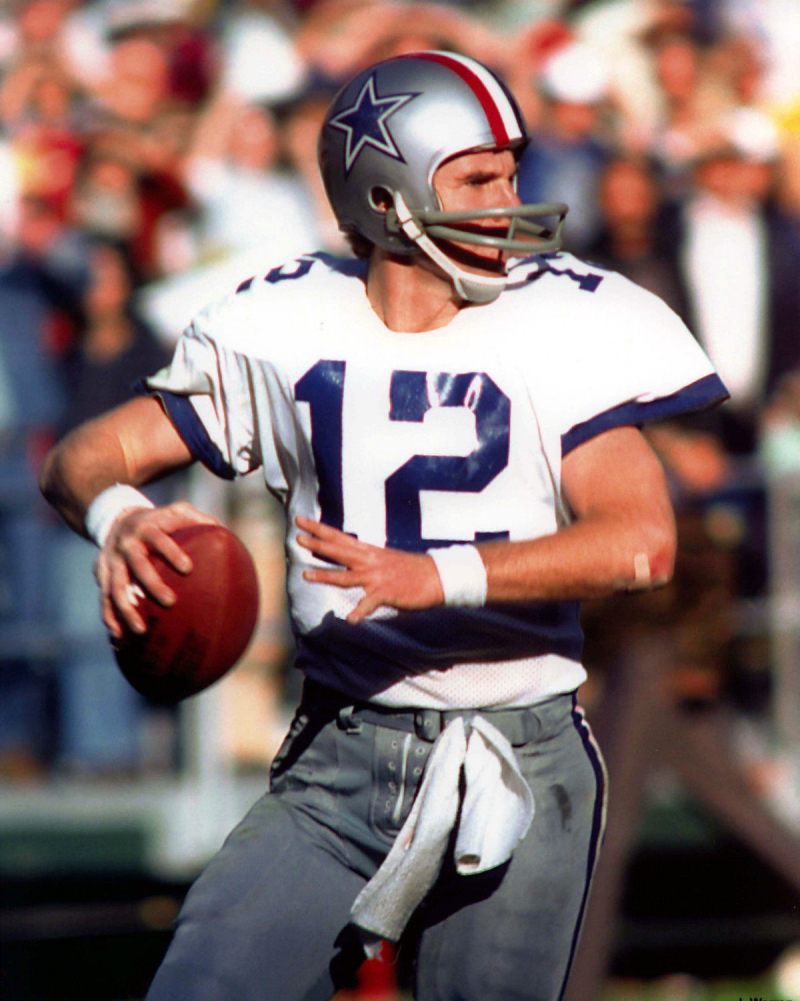
abc7ny.com












